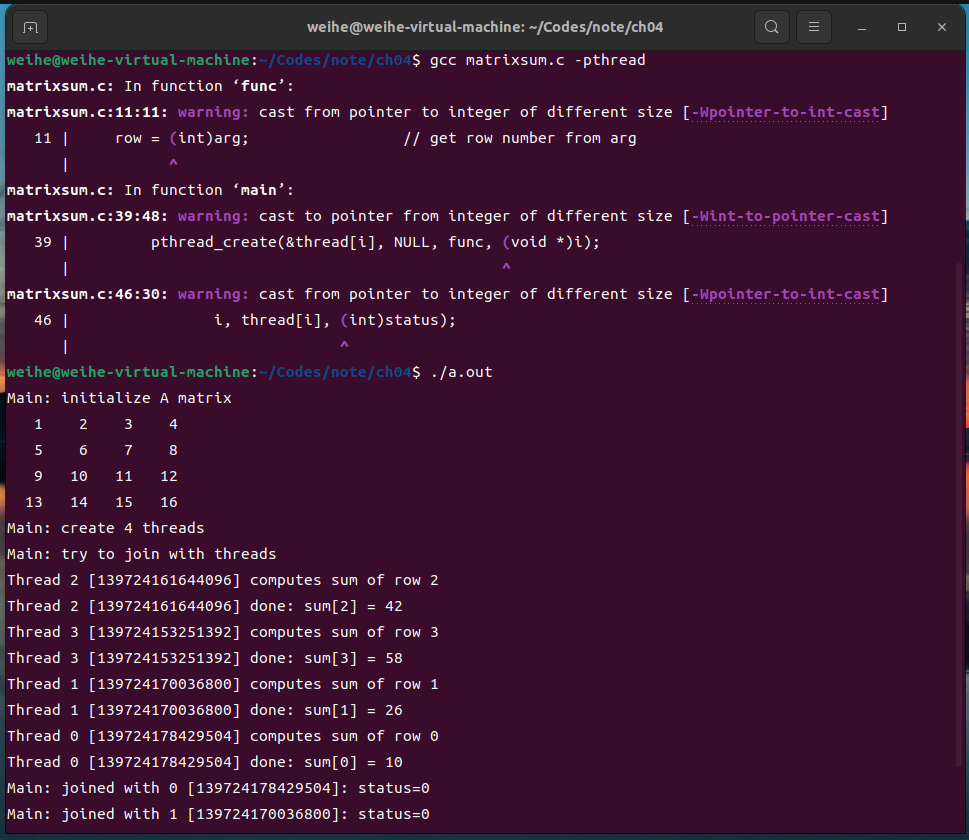《Unix&Linux系统编程》第四章学习笔记
第4章 并发编程
在早期,大多数计算机只有一个处理组件,即中央处理器CPU,受此硬件条件的限制,计算机程序通常是为串行计算编写的,在只有一个CPU的情况下,每次只能按顺序执行某算法的一个指令和步骤。但基于分治原则的算法经常表现出高度的并行性,可通过并行或并发执行来提高计算速度。近年来,随着多核处理器的出现,大多数操作系统都支持对称多处理(SMP)。
4.1 并行计算导论
1.顺序算法与并行算法
- 顺序算法
begin
step_1
step_2
···
step_n
end
- 并行算法
cobegin
task_1
task_2
···
task_n
coend
2.并行性与并发性
并行算法通常只识别可并行执行的任务,但没有规定如何将任务映射到处理组件。理想情况下,并行算法中的任务都同时执行,但只能在多处理器或多核系统中实现。
在单CPU系统中,并发性是通过多任务处理来实现的。
4.2 线程
1.线程的原理
线程是某进程同一地址空间上的独立执行单元,创建讴歌进程就是在一个唯一地址空间创建一个主线程。当某进程开始时,就会执行该进程的主线程。如果只有一个主线程,那么进程和线程没有区别。
- 如果一个线程被挂起,其他线程可以继续执行。
- 除共享共同的地址空间外,线程还共享进程的其他资源(用户id,打开的文件描述符,信号等)
2.线程的优点
- 线程创建和切换速度更快
- 线程的响应速度更快
- 线程更适合并行计算
3.线程的缺点
- 需要来自用户的明确同步(由于地址空间共享)
- 许多库函数对线程不安全
- 单CPU系统上,使用线程比使用顺序程序慢(创建线程和切换上下文的系统开销)
4.3 线程操作
- 内核模式:对内核进行系统调用,变为挂起、激活以继续执行等。
- 用户模式:线程在进程的相同地址空间中执行,每个线程都有自己的堆栈。
4.4 线程管理函数
1.创建线程
- pthread_create函数
int pthread_create (pthread_t *pthread_id,pthread_attr_t *attr,
void *(*func)(void *), void *arg);
//成功返回0,失败返回错误代码
//pthread_id:指向pthread_t类型变量的指针
//attr:指向另一种不透明数据类型的指针,指定线程属性
//func:要执行的新线程函数的入口地址
//arg:指向线程函数参数的指针
2.线程ID
一种不透明的数据类型的,取决于实现情况
int pthread_equal(pthread_t t1, pthread_t t2);//比较线程ID
如果是不同的线程,返回0,否则返回非0。
3.线程终止
线程函数结束后,即终止。
int pthread_exit (void *status);//显示终止
正常终止返回0,异常终止返回非0。
4.线程连接
一个线程连接可以等待另一个线程的终止
int pthread_join(pthread_t thread, void **status_ptr);//终止线程的退出状态以status_ptr返回
4.5 线程示例程序
1.用线程计算矩阵的和
#include <stdio.h>
#include <stdlib.h>
#include <pthread.h>
#define N 4
int A[N][N], sum[N] ;
void *func (void *arg) //threads function
{
int j, row;
pthread_t tid = pthread_self(); //get thread ID number
row = (int)arg; //get row number from arg
printf("Thread %d [%lu] computes sum of row %d\n", row, tid, row);
for (j=0; j<N; j++) //compute sum of A[row]in globalsum(row]
sum[row] += A[row][j];
printf("Thread %d [%lu] done: sum[%d] = %d\n",
row, tid, row, sum[row]);
pthread_exit((void*)0); //thread exit: 0=normal termination
}
int main (int argc, char *argv[])
{
pthread_t thread[N] ; //thread IDs
inti, j, r, total = 0;
void *status;
printf ("Main: initialize A matrix\n");
for (i=0; i<N; i++){
sum[i] = 0;
for (j=O; j<N; j++){
A[i][j] = i*N + j + 1;
printf("%4d ", A[i][j]) ;
}
printf("\n") ;
}
printf("Main: create %d threads\n", N) ;
for(i=0; i<N; i++){
pthread_create (&thread[i], NULL, func, (void *)i);
}
printf("Main: try to join with threads\n") ;
for(i=0; i<N; i++){
pthread_join(thread[i], &status);
printf("Main: joined with %d [%lu]: status=%d\n",
i, thread[i], (int)status);
}
printf("Main: compute and print total sum: ");
for (i=0; i<N; i++)
total += sum[i];
printf("total = %d\n", total);
pthread_exit (NULL) ;
}
运行结果:

2.用线程快速排序
#include <stdio. h>
#include <stdlib.h>
#include <pthread.h>
typedef struct
{
int upperbound;
int lowerbound;
} PARM;
#define N 10
int A[N] = {5,1,6,4,7,2,9,8,0,3};
int print()
{
int i;
printf("[ ") ;
for (i=0; i<N; i++)
printf("%d ", a[i]);
printf("]\n") ;
}
void *qsort (void *aptr)
{
PARM *ap, aleft, aright;
int pivot, pivotIndex, left, right, temp;
int upperbound, lowerbound;
pthread_t me, leftThread, rightThread;
me = pthread_self() ;
ap = (PARM *)aptr;
upperbound = ap->upperbound;
lowerbound = ap->lowerbound;
pivot = a[upperbound];
left = lowerbound - 1;
right = upperbound;
if (lowerbound >= upperbound)
pthread_exit (NULL) ;
while (left < right) {
do { left++; }
while (a[left] < pivot) ;
do { right--; }
while (a[right] > pivot) ;
if (left < right ) {
temp = a[left] ;
a[left] = a[right];
a[right]= temp;
}
}
print() ;
pivotIndex = left;
temp = a[pivotIndex];
a[pivotIndex] = pivot;
a[upperbound] = temp;
aleft.upperbound = pivotIndex - 1;
aleft.lowerbound = lowerbound;
aright.upperbound = upperbound;
aright.lowerbound = pivotIndex + 1;
printf("%lu: create left and right threads\n", me);
pthread_create(&leftThread,NULL, qsort, (void *)&aleft);
pthread_create(&rightThread, NULL, qsort, (void *) &aright);
pthread_join (leftThread, NULL) ;
pthread_join (rightThread, NULL);
printf("%lu: joined with 1eft & right threads\n", me);
}
int main(int argc, char *argv[])
{
PARM arg;
int i, *array;
pthread_t me, thread;
me = pthread_self() ;
printf("main %lu: unsorted array = ",me);
print();
arg.upperbound = N-1;
arg.lowerbound = 0;
printf("main %lu create a thread to do QS\n", me);
pthread_create (&thread,NULL, qsort, (void *)&arg);
pthread_join(thread, NULL) ;
printf( "main %lu sorted array = ",me);
print() ;
}
4.6 线程同步
当多个线程试图修改同一共享变量或数据结构时,如果修改结果取决于线程的执行顺序,则称之为竞态条件。在并发程序中,绝不能有竞态条件。
1.互斥量
锁:允许执行实体仅在有锁的情况下才能继续执行的同步工具。
在Pthread中,锁被称为互斥量,意为*互相排斥**。
- 静态方法
pthread_mutex_t m = PTHREAD_MUTEX_INITIALIZER
- 动态方法
使用pthread_mutex_init()函数
2.死锁预防
互斥量使用封锁协议,如果某线程不能获取互斥量,就会被阻塞,等待互斥量解锁后再继续。
死锁是一种状态,许多执行实体相互等待,都无法继续下去。
有多种方法可以解决死锁问题:死锁预防、死锁规避、死锁检测和恢复等。
3.条件变量
提供了一种线程协作的方法
- 静态方法
pthread_cond_t con = PTHREAD_COND_INITIALIZER
- 动态方法
使用pthread_cond_init()函数
4.信号量
是一种数据结构,必须使用一个初始值和一个空等队列进行初始化。从执行实体的角度来看,对信号量的操作都是原子操作或基本操作。
5.屏障
线程连接操作允许某线程等待其他线程终止,在Pthread中,可以采用的机制是屏障以及一系列屏障函数。
6.Linux中的线程
Linux不区分线程和进程,它们都是由clone()系统调用创建的。


